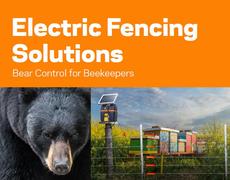High-tensile electric fences last for a long time, are relatively easy to construct, and cost less than other types of fencing. Whereas cattle can often be controlled with 1 or 2 strands of electric wire, sheep require multiple strands, not so much to keep them in, but to keep potential predators out.
Five, six or seven strands of 12 ½ gauge high-tensile wire is common for sheep fences. The bottom wires of the fence are more closely spaced than the top wires. Wire spacings of approximately 6, 5, 5, 8 and 10 inches are typical. In areas where there is relatively even rainfall and some green vegetation most of the year, it is recommended that all wires be hot.
Ground return wires are recommended where there is low rainfall, stony and dry soil conditions, or where the ground is frequently frozen or snow covered. Switches can be installed so that wires can be turned off if the situation warrants. For example, it is useful to put a switch on the wire closest to the ground, so that it can be turned off if there is too much vegetation on the fence line.
High-tensile fences are made with smooth wire that is pulled to an initial tension of 250 pounds. They require strong corners and end braces to achieve adequate tension. The wire is held on fence posts with staples. These staples are driven at a slight angle off of vertical so the slash cut points steer the staple into different grains of the wood. The staples are not driven tight against the wire, but instead allow freedom for the wire to move during tensioning, temperature changes, or livestock pressure.
Grounding
Poor grounding is the leading cause of electric fence failures. An electric fence must be properly grounded so that the pulse can complete its circuit and give the animal an effective shock. It is important to follow manufacturer's instructions for grounding electric fences. A minimum of three ground rods should be used for each energizer. It is estimated that 80% of electric fences in the U.S. are improperly grounded. A voltmeter is an inexpensive tool that measures the charge the fence delivers and can be used to trouble shoot electric fence problems.
The charger
The charger (or energizer) is the "heart" of the electric fence system. It converts main or battery power into a high voltage pulse or "shock" as felt by the animal when it touches the fence. In the past, electric fence chargers shorted out easily. Today's chargers are low impedance, meaning they are designed to effectively shock though vegetation and other foreign materials touching the fence.
A 4,000 volt charger is usually sufficient for sheep. The number of joules needed depends on the length of the fence, the number of electrified wires and the severity of conditions. A joule is the amount of energy released per pulse. As a general rule, 1 joule will power 6 miles of single fence wire; 4.5 joules is usually adequate for 20 to 50 acres. Lightning strikes can damage energizers. Surge protectors and lightening arrestors are recommended to minimize energizer damage.
High tensile electric fencing requires periodic upkeep. Fence wires should be kept properly tensioned. Weeds and brush should be cleared from the fence line by spraying or mowing.
It is important to note that an electric fence much more of a psychological barrier rather than a physical one. Sheep and lambs must be trained to respect electric fence. Once trained, they will usually respect the fence even if it is off for any reason.





